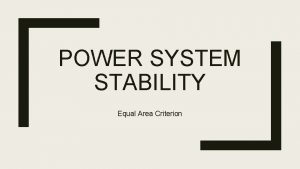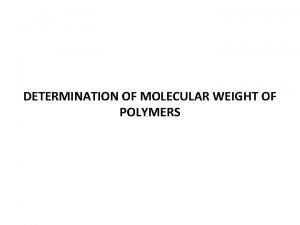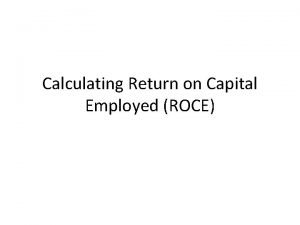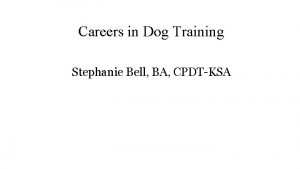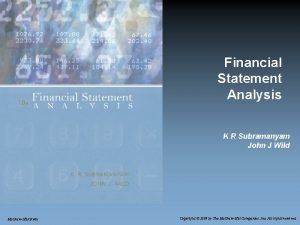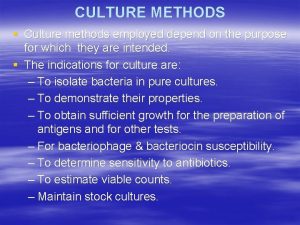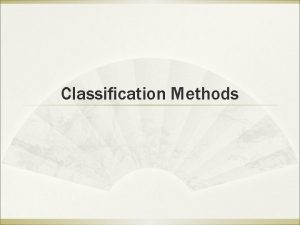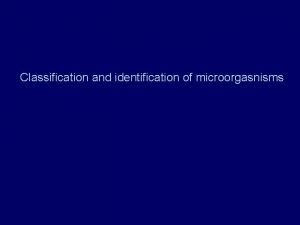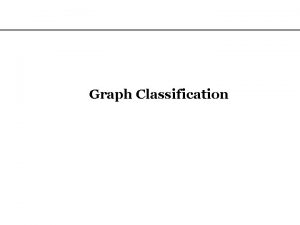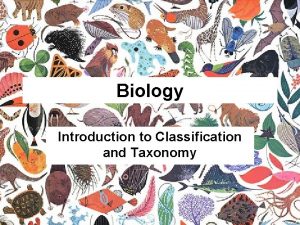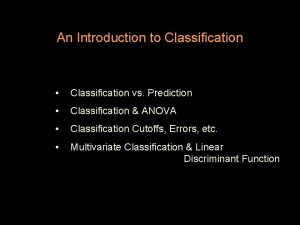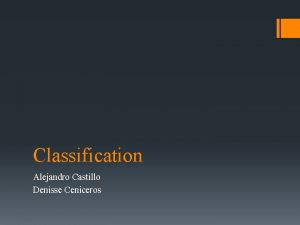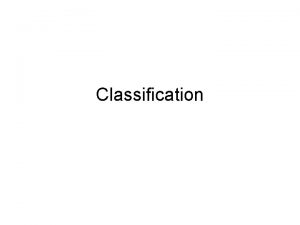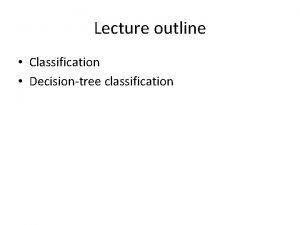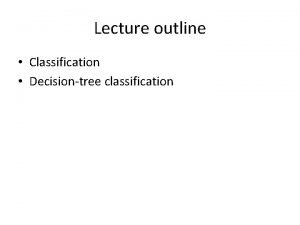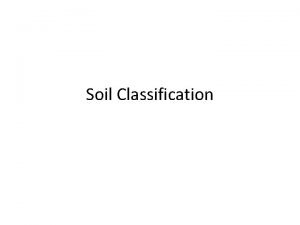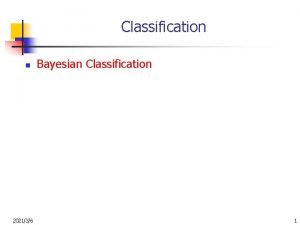Introduction Classification of the methods employed to determine

























- Slides: 25

Introduction Classification of the methods employed to determine the moisture content of agricultural products 1. Oven methods 2. Chemical methods 3. Distillation methods 4. Others * Electronic moisture testers * Infrared moisture determination balances * Microwave methods * Near Infrared methods (Transmittance and Reflectance type) 2020/12/1 1

Air oven methods Organization Products Japan USDA ISO Cereal grain 105℃ 5 hrs 130℃ 1 hr 130℃ 2 hrs Beans 105℃ 5 hrs 130℃ 1 hr 130℃ 2 hrs Peas and lentils 105℃ 5 hrs 130℃ 1 hr 130℃ 2 hrs Maize [Food] [Feed] 105℃ 5 hrs 135℃ 103℃ 72 hrs 130 -133℃ 4 hrs Grain Sorghum [Food] [Feed] 105℃ 5 hrs 135℃ 2 hrs 130℃ 1 hr 130℃ 2 hrs Soybeans 105℃ 5 hrs 130℃ 1 hr 103℃ 3 hrs +αhr 2020/12/1 2

Air oven methods 1. 2. 3. ISO 712 : cereal grain JAPAN 105 C : cereal grain ISO 6540 : maize

International Standard ISO 712 (forth edition 2009) Cereals and cereal products ― Determination of moisture content Routine reference method 2020/12/1 4

ISO 712 n n n n 1. Application 2. Definition 3. Apparatus 4. Preparation of the test sample 5. Procedure 6. Calculation and expression of results 7. Precision 8. Test report 2020/12/1 5

ISO 712 1. Application n n This method is applied to : wheat, rice, (paddy, husked and milled), barley, millet, rye, oats, sorghum in form of grain, milled grains, and semolina or flour Not applicable to maize and pulses 2020/12/1 6

ISO 712 2. Definition n n Loss in mass, expressed as a percentage, undergone by the product under the conditions specified in this standard Moisture content is expressed as a percentage 2020/12/1 7

ISO 712 3. Apparatus 1) Analytical balance 2) Grinding mill 3) Metal dish 4) Oven 5) Desiccator 2020/12/1 8

ISO 712 3. Apparatus-1 1) Analytical balance Capable of weighing to an accuracy of ± 1 mg 2020/12/1 9

ISO 712 3. Apparatus-2 2) Grinding mill not absorb moisture, easy to clean, without heat, tightness to air, particles of the dimensions in Table 1. 2020/12/1 10

ISO 712 3. Apparatus-2 -Table 1 1 ― Particle size distribution of products not requiring grinding Particle size (mm) Proportion (%) ≦ 1. 7(1. 8)a 100 Table > 1. 0(1. 0)b < 0. 5(0. 56)a <10 >50 a Sieve through which this particle size passes. b Sieve through which this particle size does not pass. Products having the particle size distribution given in Table 1 do not need to be ground before the determination 2020/12/1 11

ISO 712 3. Apparatus-3 3) Metal dish (can) Non-corrodible, tight-fitting, an effective surface area (not more than 0. 3 g/cm 2) or glass dish 2020/12/1 12

ISO 712 3. Apparatus-4 4) Oven ・Constant and stable for 2 h at 130~ 133゜C ・Regain time in less than 30 min ・Effective ventilation 2020/12/1 13

ISO 712 3. Apparatus-5 5) Desiccator Containing an effective desiccant 2020/12/1 14

ISO 712 4. Preparation of the test sample-1 If the characteristics of sample confirm to Table 1, it shall not be ground. If the characteristics of sample does not confirm to Table 1, the sample shall be ground. 1) The sample without pre-conditioning* when its moisture content is the value between 9% and 15%. 2) Products shall be pre-conditioned so as to bring their moisture content to the value between 9% and 15%. *pre-conditioning: If the moisture content is out of the range , dry or moisten the sample before the grinding. 2020/12/1 15

ISO 712 4. Preparation of the test sample-2 sample NO large particle size YES preconditioning NO most9%~ 15% YES grinding preparation sample 2020/12/1 16

ISO 712 4. Preparation of the test sample-3 n n If the moisture content is more than 15%, 1) Provide at least 2 test portions with the amount slightly greater than 5 g for each. 2) Measure the weight of each test portion with a resolution of 1 mg. 3) Carry out a pre-drying operation, at 130℃~ 133℃. 4) For approximately the time of heating shall be 7 min to 10 min. 5) The cooling of pre-dried test portions to laboratory temperature shall be carried out with dishes uncovered, for at least 2 h. If the moisture content is less than 9%, carry out a pre-moistening operation in suitable atmosphere until the moisture content become a value between 9% and 15%. 2020/12/1 17

ISO 712 5. Procedure 1) Number of determination The repeat determination of moisture content when the absolute difference between the two moisture results on the test portions exceed repeatability limit. 2) Test portion Rapidly weigh, to the nearest 1 mg, a quantity of 5 g ± 1 g of the laboratory sample in the dishes. 3) Drying Place the open dish containing the test portion together with the lid, in the oven and leave for 120 min ± 5 min (90 min for flours) from the moment when the oven temperature is regained to 130゚C± 3゚C. Do not open the oven door during drying. 4) Weighing When the dishes have been cooled to the laboratory temperature, weigh them to the nearest 1 mg. 2020/12/1 18

ISO 712 6. Calculation and expression of results n n The moisture content, m. H 20, expressed as percentage by mass is given by the following equations. 1) Without pre-conditioning m. H 20 =(1 – w 1/w 0)× 100% where w 0 and w 1 are the weights, in grams, of the test portion and the dried test portion, respectively. 2) With pre-conditioning m. H 20 ={1 – ( w 1 w 3)/(w 0 w 2)}× 100% where w 2 and w 3 are the weights of the test portions before and after pre-conditioned, respectively. The result is the arithmetic mean of two measurements values which meet the repeatability requirement. Round the result to two places of decimals. 2020/12/1 19

ISO 712 7. Precision-1 1) Interlaboratory test The interlaboratory tests can only be applied to other moisture contents in the range 10% to 18%. (Annex A Table A-1) 2) Repeatability, r; obtained using the same method on identical test material in the same laboratory by the same operator using the same equipment carried out within a short interval of time; r = 2. 77 sr =2. 77 × 0. 043=0. 12 sr is the standard deviation of repeatability 3) Reproducibility, R; obtained using the same method on identical test material in different laboratories with different operators using different equipment; R = 2. 77 sr =2. 77 × 0. 1614=0. 45 2020/12/1 20

ISO 712 7. Precision-2 4) Comparison of two groups of measurements in one laboratory The Critical difference (CD) between two averaged values obtained from two test results under repeatability conditions. 2. 8 sr√(1/2 n 1+1/2 n 2)= 2. 8 sr√(1/2)=1. 98 sr=0. 09=0. 1 5) Comparison of two groups of measurements in two laboratories The CD between two averaged values obtained from two different laboratories from two test results repeatability conditions. 2. 8√(s. R 2 -sr 2(1 -1/2 n 2))=2. 8 √(s. R 2 -0. 5 sr 2)=0. 51=0. 5 6)Uncetainty , Ue; estabulished through the statistical distribution of results, the experimental standard deviation given by the interlaboratory test Ue= ± 2 s. R=± 2× 0. 16=± 0. 30 (k=2) 2020/12/1 21

ISO 712 8. Test Report n n n n Information 1) Sample identification 2) sampling method 3) reference to International Standard 4) test results 5) repeatability 6) operating details, influenced the test results 2020/12/1 22

ISO 712 Annex A Results of interlabpratory test n n 2020/12/1 19 laboratories took part. 7 products were analysed 23

Table A. 1 -Statistical results of the interlaboratory test Products Parameters Semolina Common Wheat 1 Barley Rice Durum Wheat 1 Durum Wheat 2 Common Wheat 2 a)Lab. no 17 18 18 17 18 14 14 b)mean 10. 50 11. 91 12. 67 14. 17 14. 59 16. 92 17. 87 c)sr 0. 03 0. 05 004 0. 03 0. 06 0. 05 d)Cvr(sr/WH 2 O)% 0. 29 0. 42 0. 32 0. 28 0. 21 0. 35 0. 28 e)r(2. 77 sr) 0. 08 0. 14 0. 11 0. 08 0. 17 0. 14 f) s. R 0. 13 0. 17 0. 16 0. 21 0. 19 0. 14 g)Cv. R(s. R/WH 20)% 1. 24 1. 09 1. 34 1. 13 1. 44 1. 12 0. 78 h)R(2. 77 s. R) 0. 36 0. 47 0. 44 0. 58 0. 53 0. 39 2020/12/1 Overall mean 0. 04 0. 16 a) No. of participating laboratories after eliminating outliners b) Mean value, WH 20, g/100 g c) Repeatability standard deviation, sr d) Coefficient of variation of repeatability, Cvr (sr /WH 2 O)% e) Repeatability limits, r(2. 77 sr) f) Reproducibility standard deviation, s. R g) Coefficient of variation of reproducibility, Cv. R (s. R /WH 20)% f) Reproducibility limit, R(2. 77 s. R) 24 24

Thank You for your attention!
 Equal area criteria
Equal area criteria Polymer molecular weight determination
Polymer molecular weight determination Direct wax pattern technique
Direct wax pattern technique Plateau characteristics
Plateau characteristics Goodwill valuation methods
Goodwill valuation methods Capital employed means
Capital employed means How to calculate roce
How to calculate roce First somatic hybrid in plant was obtained by
First somatic hybrid in plant was obtained by Steps of remedial teaching
Steps of remedial teaching Self-employed dog trainer salary
Self-employed dog trainer salary Annuity method of goodwill
Annuity method of goodwill Bone swaging in dentistry
Bone swaging in dentistry Igcse business studies formula sheet
Igcse business studies formula sheet Noa turnover
Noa turnover Hát kết hợp bộ gõ cơ thể
Hát kết hợp bộ gõ cơ thể Slidetodoc
Slidetodoc Bổ thể
Bổ thể Tỉ lệ cơ thể trẻ em
Tỉ lệ cơ thể trẻ em Gấu đi như thế nào
Gấu đi như thế nào Tư thế worm breton
Tư thế worm breton Bài hát chúa yêu trần thế alleluia
Bài hát chúa yêu trần thế alleluia Kể tên các môn thể thao
Kể tên các môn thể thao Thế nào là hệ số cao nhất
Thế nào là hệ số cao nhất Các châu lục và đại dương trên thế giới
Các châu lục và đại dương trên thế giới Công của trọng lực
Công của trọng lực Trời xanh đây là của chúng ta thể thơ
Trời xanh đây là của chúng ta thể thơ
